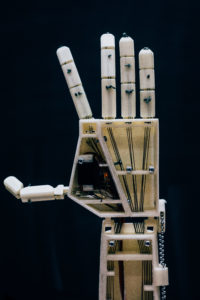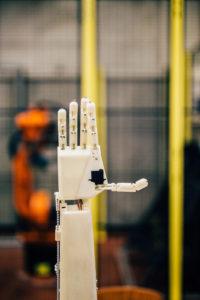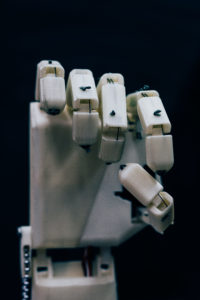 When I was in high school, I worked as a camp counselor for a summer camp at which many of the children were hearing impaired. I learned quite a bit of sign language while working at that job, but I’ve forgotten much of it by now, which makes me sad – it was so helpful to be able to communicate with people who were incapable of hearing spoken words. I believe that sign language should be much more widely taught than it is now, because there is a shortage of sign language interpreters in the world, resulting in communication barriers between hearing people and hearing-impaired people.
When I was in high school, I worked as a camp counselor for a summer camp at which many of the children were hearing impaired. I learned quite a bit of sign language while working at that job, but I’ve forgotten much of it by now, which makes me sad – it was so helpful to be able to communicate with people who were incapable of hearing spoken words. I believe that sign language should be much more widely taught than it is now, because there is a shortage of sign language interpreters in the world, resulting in communication barriers between hearing people and hearing-impaired people.
Three engineering students from the University of Antwerp are very aware of this communication barrier, particularly in Belgium where there are very few people fluent in sign language. Guy Fierens, Stijn Huys and Jasper Slaets decided to use their engineering work to come up with a technological solution to the problem.
“I was talking to friends about the shortage of sign language interpreters in Belgium, especially in Flanders for the Flemish sign language,” said Huys. “We wanted to do something about it. I also wanted to work on robotics for my masters, so we combined the two.”
Rather than trying to facilitate the implementation of sign language training programs in schools across the country or the world, which would be a massive project, the students decided to create a robot that could communicate through sign language instead. With help from a robotics teacher and an ENT surgeon, as well as fellow students, they started Project Aslan, which stands for Antwerp’s Sign Language Actuating Node.
The project began three years ago, and today Project Aslan has produced a 3D printed robotic arm capable of converting text into sign language, including finger spelling and counting. It’s not just specific to Belgium, either – Aslan will be available in more than 140 countries, thanks to 3D Hubs.
“A deaf person who needs to appear in court, a deaf person following a lesson in a classroom somewhere. These are all circumstances where a deaf person needs a sign language interpreter, but where often such an interpreter is not readily available,” said Erwin Smet, the robotics teacher who worked with the students on the project. “This is where a low-cost option, like Aslan can offer a solution.”
The students decided to use 3D printing for the robot because of its inexpensive cost, which would allow for affordable production and an easy way to replace parts if they broke or needed updates. They partnered with 3D Hubs because of the organization’s broad reach. The first prototype consisted of 25 3D printed PLA parts, which took 139 hours to print, plus an Arduino Due, 16 servo motors, 3 motor controllers and several other components. Full assembly takes about 10 hours.
 Aslan works by receiving information from a local network, then checking for updated sign languages from around the world. Messages can be transmitted by users connected to the network, and the robot’s hand, elbow and finger joints are activated to convey the messages. The robot isn’t intended to be a replacement for human sign language interpreters, rather a helpful tool that can fill in when human interpreters aren’t available, or to offer assistance in sign language classes.
Aslan works by receiving information from a local network, then checking for updated sign languages from around the world. Messages can be transmitted by users connected to the network, and the robot’s hand, elbow and finger joints are activated to convey the messages. The robot isn’t intended to be a replacement for human sign language interpreters, rather a helpful tool that can fill in when human interpreters aren’t available, or to offer assistance in sign language classes.
Although the robotic arm is now functional, the project is ongoing. Future work, to be carried out by new masters students at the University of Antwerp, will include creating a two-arm design as well as adding facial expressions to the robot. Students will also look into the possibility of using a webcam to teach new gestures to the robot, involving the movements of the shoulders and face in addition to the arms.
Once the robot has reached a more advanced level, the design will be made open source. You can learn more about Project Aslan here. Discuss in the Project Aslan forum at 3DPB.com.
[Images: 3D Hubs]
Subscribe to Our Email Newsletter
Stay up-to-date on all the latest news from the 3D printing industry and receive information and offers from third party vendors.
You May Also Like
Printing Money Episode 17: Recent 3D Printing Deals, with Alex Kingsbury
Printing Money is back with Episode 17! Our host, NewCap Partners‘ Danny Piper, is joined by Alex Kingsbury for this episode, so you can prepare yourself for smart coverage laced...
Insights from Cantor Fitzgerald on AM’s Q1 2024 Landscape
A recent survey by Cantor Fitzgerald sheds light on the persistent challenges within the additive manufacturing (AM) industry in the first quarter of 2024. Based on responses from 38 industry...
3D Printing Financials: Xometry’s Scaling up and Strong Start to 2024
Xometry (Nasdaq: XMTR) kicked off 2024 with strong results, boosting its marketplace and technology to new heights. Both revenue and gross margin soared, fueled by an expanding global network of...
3D Printing Financials: Desktop Metal Targets Recovery Amid Net Losses and Revenue Downturn
Despite facing a decline in revenue and the persistent challenges of a tight economic climate, Desktop Metal (NYSE: DM) is making strides toward operational efficiency. The first quarter of 2024...




































